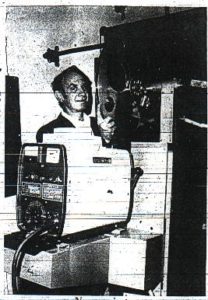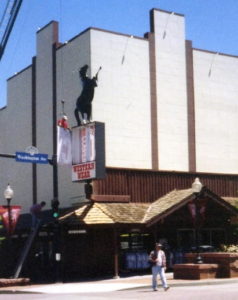
Closed Golden Theatre From the Golden Transcript, 1972
As time went on, the movie industry changed around the classic movie palaces like the Golden. In 1956 the Atlas chain threatened to close the theater due to a critical shortage of patrons. Denver theaters were showing movies two to three weeks before suburban theaters could, and patrons chose to drive to them instead. The Golden Chamber of Commerce, mindful of the economic hardship downtown faced when the theater had closed for renovations, immediately stood at the front of its defense, believing the theater’s loss would be a black eye to downtown and the community. Atlas gave Golden a second chance, knowing a promising movie would be showing at the Golden soon. Goldenites responded, and the theater gained a new lease on life. The name of the movie that saved it: The Searchers, starring John Wayne.
In 1966, amid hot accounts that the Fox chain was to build a large new drive-in theater at West Colfax Avenue and Highway 6, the Golden was renovated for the fourth time, when Atlas installed new seats and completely redecorated the walls. However, the competition was fiercely on the heels of the Golden, with the advent of twin cinemas fast bleeding away its traffic. In a last-ditch effort to keep his theaters open, Yeager converted the Atlas chain to showing pornographic films, outraging the public and prompting protests at the Oriental and Federal theaters in Denver. In Golden, prominent merchant Frederick Allen “Heinie” Foss figured with the nearby predominantly young male populace of the School of Mines the concept would be successful. However, he did not figure this to be best by any means for downtown and Golden’s people, and the outcry had shuttered the theater in 1970, so he and his wife Barbara took matters into their own hands and purchased the Golden in 1972 from Atlas, which faded into oblivion not long thereafter.

Bill Ramsey with new theater projector
Photo courtesy Golden Transcript, 1972
Foss hired veteran theater manager Bill Ramsey to reopen the Golden as a place to show old-time family film classics. Ramsey believed the prime purpose of movies was to entertain, and he instituted his “nostalgia policy” to do the entertaining. The three downtown Golden banks (Golden State, Golden Savings & Loan and First National) offered free parking for patrons in the evening, as well as one free movie a month for the public. Unfortunately, however, the Golden’s fate had only been postponed. After losing this operator and another afterward, Foss turned to the Chamber empty-handed and at a loss what to do with the place. Finally, after operating for 68 years to the delight of Golden’s people, the theater finally closed down in 1976.
The building that housed the theater for most of those years was renovated by Foss into the Theater Building. Its seats were taken out and interior partially gutted, renovated and divided into three commercial spaces. Entrances for two of the new retail rooms were carved with new display windows from the 13th Street facade, while the ticket booth, glass block and marquee were taken out on the Avenue side. The first floor facades were boarded over in broadboard planking and a wraparound canopy in the style of downtown’s 1960s urban renewal project was built. That fall, Steve Steinhoff opened Steve’s Corner, which became a well noted western wear store of the Denver area. It was joined in the building by the Fabric Gallery and Royal Image Lighting, but in time Steve’s Corner took over the entire place. Operating under its landmark revolving horse sign on the outside, Steve’s Corner branched out to Thornton and High Country Western Wear.


Horses of different colors – the 2nd and 3rd horses at Steve’s Corner
Photos courtesy Gardner Family Collection, 1990s and 2000
After many successful years, and losing its horse twice to burning up and blowing off in the latter 1990s, Steve’s Corner closed down in 2000. In the meantime in the 1990s grand plans were made again to restore movies to Golden, first with a 24-screen AMC theater and then 16-screen Mann theater at Interplaza West, but both plans fizzled after the movie theater industry crashed. After Steve’s Corner closed, the historic theater building was purchased by Jim Garrick, who took out the retrofitted interior and remade it into three stories, giving the interior its first metal supports since 1912. The wood and canopy were destroyed, and the building’s bold towering personality made its presence known on the Avenue once again. The movie poster box openings were converted into windows, and a number of other smaller windows were installed across the facade, and the two towers remained as downtown Golden’s last landmark of Art Deco design.
Meanwhile, citizens of Golden have worked to establish the 5th movie house in Golden’s history. On June 1, 2002, 90 years to the hour after the permanent home of the Gem opened, the Golden Resource for Entertainment, Arts & Theatre showed Golden’s first films in 26 years at the American Mountaineering Center, the same location where Golden’s moviegoing history all began back in 1908. This highly successful exhibition of historical films included Golden’s second run of The Bandit King, 94 years after its premiere on the same premises. Later GREAT created Golden’s outdoor film festival. Many hope that someday in the future a true movie house will once again grace the streets of Golden.
